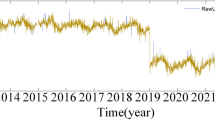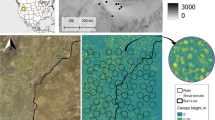Abstract
A quadtree-based image segmentation procedure (HQ) is presented to map complex environmental conditions. It applies a hierarchical nested analysis of variance within the framework of multiresolution wavelet approximation. The procedure leads to an optimal solution for determining mapping units based on spatial variability with constraints on the arrangement and shape of the units. Linkages to geostatisiics are pointed out, but the HQ decomposition algorithm does not require any homogeneity criteria. The computer implementation can be parameterized by either the number of required mapping units or the maximum within-unit variance, or it can provide a “spectrum” of significances of nested ANOVA. The detailed mathematical background and methodology is illustrated by a salt-affected grassland mapping study (Hortobágy, Hungary), where heterogeneous environmental characteristics have been sampled and predicted based on remotely sensed images using these principles.
Similar content being viewed by others
References
Burgess, T. M., Webster, R., and McBratney, A. B., 1991. Optimal interpolation and isarithmic mapping of soil properties IV: sampling strategy: Jour. Soil Science, v. 32. no. 2, p. 643–659.
Cressie, N., 1991, Statistics for spatial data: John Wiley & Sons, New York, 900 p.
Csillag, F., 1991, Resolution revisited: Proc. AutoCarto-10. Am. Soc. Photogrammetry and Remote Sensing (Bethesda, Maryland), p. 15–29.
Csillag, F., and Kertész, M., 1989, Spatial variability: error in natural resource maps? Agrokémia és Talajtan v. 37, no. 4. p. 715–726.
Csillag, F., Kertész, M., and Kummert, á., 1992, Resolution, accuracy and attributes: approaches for environmental geographical information systems: Computers, Environment and Urban Systems, v. 16, no. 4, p. 289–297.
Csillag, F., Kertész, M., and Kummert, á., 1995, Sampling and mapping of heterogeneous surfaces: multiresolution tiling adjusted to local variability: Intern. Jour. Geographical Information Systems, in press.
Csiszár, I., 1975, I-divergence geometry of probability distributions: Annals Probability, v. 3, no. 2, p. 146–158.
Curran, P., 1988, The semivariogram in remote sensing: Remote Sensing of Environment, v. 24, no. 6, p. 493–507.
Daubechies, I., 1990. The wavelet, time-frequency localization and signal analysis: IEEE Transactions on Information Theory, v. 36, no. 5. p. 961–1003.
Davidson, A., 1995, Predicting salinity status across natural grasslands by integrating field and remotely sensed data in a G1S: unpubl. masters thesis, Univ. Toronto, 121 p.
Davidson, A., and Csillag, F., 1994, Integrating remotely sensed and field data in a GIS for mapping salinity status of natural grasslands: Proc. Can. Conf. GIS. Natural Resources Canada (Ottawa), p. 1708–1718.
Deutsch, C., and Journel, A., 1993, GSLIB: a geostatistical software library: Oxford Univ. Press, Oxford, 340 p.
Englund, E., 1993, Spatial simulations: environmental applications,in Goodchild, M. F., Parks, B. O., Steyaert, L. T., eds., Environmental modeling with GIS: Oxford Univ. Press, Oxford. p. 432–437.
Goodchild, M. F., Parks, B. O., and Steyaert, L. T., eds., 1993, Environmental modeling with GIS: Oxford Univ. Press, Oxford, 488 p.
Griffith, D. A., and Csillag, F., 1993, Exploring the relationships between semi-variogram and spatial autoregressive models: Papers in Regional Science, v. 72. no. 3, p. 283–295.
Gruijter, J. J., and Braak, C. J. F., 1990, Model-free estimation from spatial samples: A reappraisal of classical sampling theory: Math. Geology, v. 22, no. 4, p. 407–415.
Heuvelink, G. B. M., 1993, Error propagation in quantitative spatial modelling: Applications in geographical information systems: unpubl. doctoral disseration. Netherlands Geographical Studies 163, Koninklijk Nederlands Aardrijkslundig Genootschap, Utrecht, 151 p.
Heuvelink, G. B. M., and Birkens, M. F. P., 1992, Combining soil maps with interpolations from point observations to predict quantitative soil properties: Geoderma, v. 55, no. 1, p. 1–15.
Kabos, S., 1993, Spatial statistics: TARKI (Social Science Research Center), Budapest (in Hungarian), 66 p.
Kertész, M., Csillag, F., and Kummert. á., 1994, Optimal tiling of heterogeneous images: Intern. Jour. Remote Sensing, in press.
Mallat, S. G., 1989, A theory for multiresolution signal decompositions: the wavelet representation: IEEE Trans. Geoscience and Remote Sensing, v. 11, p. 674–693.
Mark, D. M., 1986. The use of quadtrees in geographic information systems and spatial data handling: Proc. AutoCarto London. Roy. Inst. Chartered Surveyors (London), p. 517–526.
Mark, D. M., and Csillag, F., 1989. The nature of boundaries on “area-class” maps: Cartographica, v. 26, no. 1, p. 65–79.
Pratt, W. K., 1991, Digital image processing (2nd ed.): Wiley-Interscience, New York, 698 p.
Rajkai, K., Marchand, D., and Oertli, J. J., 1988, Study of the spatial variability of soil properties on alkali soils: Proc. Intern. Symp. Solonetz Soils Soil Science Society (Osijek), p. 150–155.
Samet, H., 1990, Applications of spatial data structures: Addison-Wesley, Reading, Massachusetts, 507 p.
Scheffé, H., 1959, The analysis of variance: John Wiley & Sons, New York, 477 p.
Strobach, P., 1991, Quadtree-structured recursive plane decomposition coding of images: IEEE Trans. Signal Processing, v. 39, p. 1380–1397.
Tobler, W., 1988, Resolution, accuracy and all that,in Mounsey, H., and Tomlinson, R. eds., Building databases for global science: Taylor & Francis, London, p. 129–137.
Tóth, T., and Rajkai, K., 1994, Soil and plant correlations in a solonetzic grassland: Soil Science, v. 157, no. 3, p. 252–262.
Tóth, T., Csillag, F., Michéli, E., and Biehl, L., 1991, Characterization of semivegetated saltaffected soils by means of field remote sensing: Remote Sensing of Environment, v. 37, no. 2, p. 167–180.
Troeh, F. R., and Thompson, L. M., 1993, Soils and soil fertility: Oxford Univ. Press, Oxford, 462 p.
Voltz, M., and Webster, R., 1990, A comparison of kriging, cubic splines and classification for predicting soil properties from sample information: Jour. Soil Science, v. 41, no. 3, p. 473–490.
Webster, R., and Oliver, M., 1990, Statistical methods in soil and land resource survey: Oxford Univ. Press, Oxford, 316 p.
Wu, J., and Levin, S. A., 1994, A spatial patch dynamic modeling approach to pattern and process in an annual grassland: Ecological Monographs, v. 64, no. 4, p. 447–464.
Author information
Authors and Affiliations
Rights and permissions
About this article
Cite this article
Csillag, F., Kabos, S. Hierarchical decomposition of variance with applications in environmental mapping based on satellite images. Math Geol 28, 385–405 (1996). https://doi.org/10.1007/BF02083652
Received:
Accepted:
Issue Date:
DOI: https://doi.org/10.1007/BF02083652




